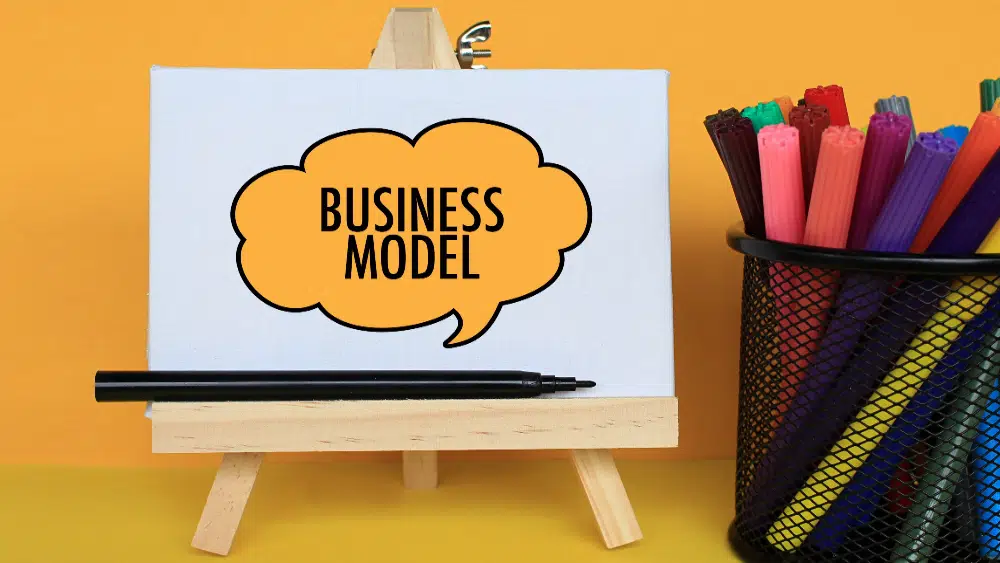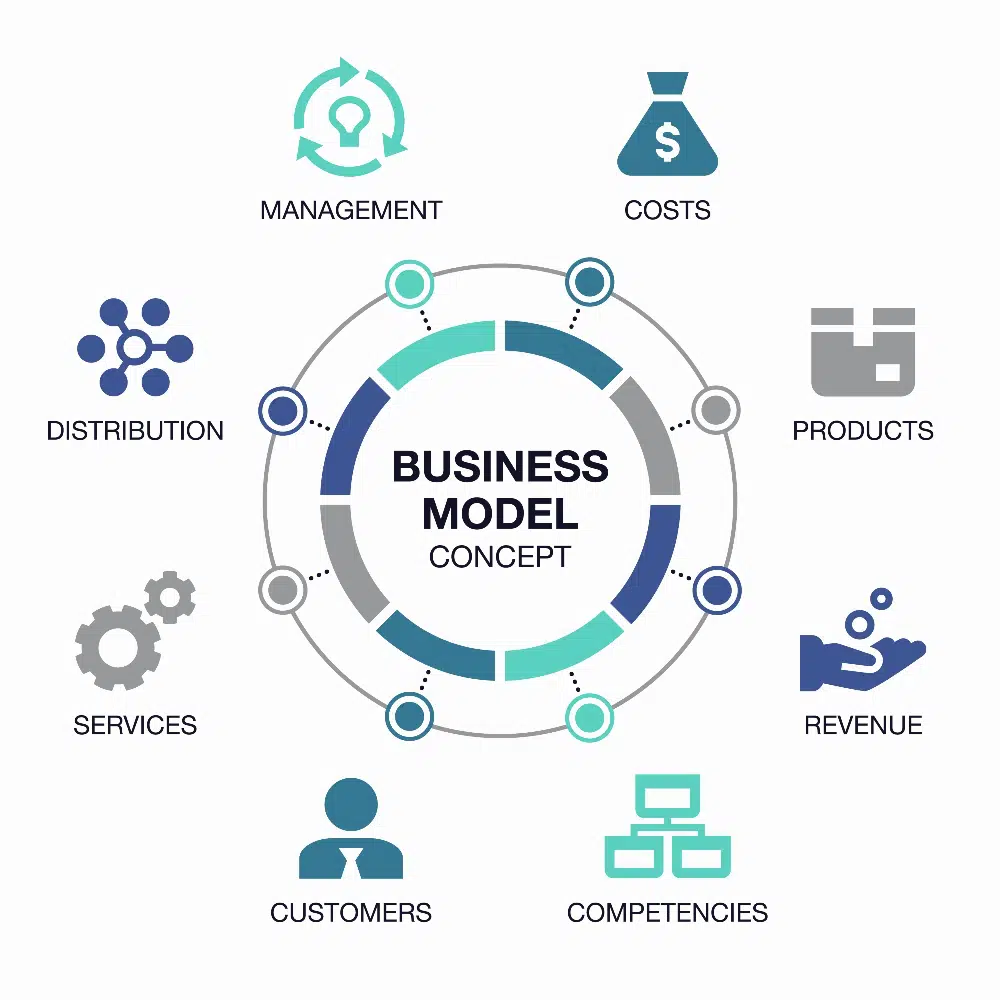This article has been contributed by Alisa Taylor.
As a freelance graphic designer, there are a myriad of avenues you can explore to generate revenue, target customers, and build your brand.

However, to do it successfully, you need a business model that matches your goals.
What is a Business Model?
A business model is similar to a business plan in that it creates a blueprint for your operation, identifies revenue streams, and your customer base. Plus, it outlines your products and services, and all financial and financing details.
But not every business model is the same, especially in the freelance world. That’s why we’ve delved into the most popular business models for freelance graphic designers
How to Frame Your Freelance Business Model
1. The Solo Model
This is what most people will think of when they imagine a freelance career — just you on your own, covering all aspects of the business.
You are the service provider (the graphic designer) as well as the marketer, the accountant, and the customer service portal. The buck starts and stops with you.
The reason that most people think of freelancing in this way is because that’s how most freelancers start out.
It gives you incredible flexibility as you’re only responsible for yourself, rather than a team. You also have higher profit margins because you aren’t sharing the income from work.
However, in the solo model, you’re limited to your time and capabilities, and growth can be tricky. There are only so many hours in a day, and you can only spread yourself so thin.
Yet this isn’t a downside if you prefer to operate alone and don’t want to grow beyond what you yourself can offer.
For graphic designers looking for a low risk, lower stress option, going solo is an excellent idea. There won’t be any need to seek out investors or spend a huge amount of money on overheads.
And if you enjoy freelancing but don’t enjoy all the admin that comes with it, you can outsource tasks like accounting, marketing, or social media management. This allows you to focus on designing without getting weighed down by all the other requirements.
The only pitfall is that outsourcing tasks pushes up your overheads. But if you take your hours of billable time and compare them to what you spend on outsourcing, you may well find you still come out ahead.
Sometimes, it’s worth paying someone who has the expertise to get the job done quickly and correctly, rather than learning how to do so yourself. This is especially true for accounting, as having an expert do your tax can save you huge sums of money both in the short and long term.
As a solo freelance graphic designer, all you really need is your computer, design software, and an internet connection.
Any other tools or equipment are an added extra and are not essential to getting your freelance business off the ground.
If freelancing doesn’t work out, or you don’t enjoy it, you won’t suffer huge financial losses.
2. The Gig Model
Once you’ve established yourself as a freelancer, it’s important to look at how you go about getting work and keeping income rolling in.
The gig business model for freelance graphic designers is great for those who don’t want to be tied to something repetitive, which can be a big creativity killer for a graphic designer.
With the gig model, you go from project to project and from client to client, working on new things all the time.
Think of it as if you were a live performer — performers get booked to perform at a specific venue or event, then get paid for the job, before moving onto the next performance.
As a graphic designer, you will focus on completing one project before you move onto the next — usually with a different client. You don’t have to commit to that client for any longer than it takes to finish the job.
The downside to this style of freelancing is that you need to be on the lookout for new clients constantly, and your marketing game must be on point.
While you get high flexibility, you also get low stability. For many graphic designers with a head for business and a flair for marketing, this isn’t an issue.
For freelancers who are great at finding new customers or can provide a top-notch quick turnaround service at a highly competitive rate, the gig model is an excellent choice. Quick turnaround times tend to lead to higher work volumes, and this improves your earning potential.
Graphic designers who offer a no-frills service or work on smaller jobs like logos, letterheads, event invites, or posters are going to have the edge here. Especially over those who take on large, multi-faceted design projects that can take weeks or even months to complete.
The gig model relies on being quick in and out, so you’ll need to be adept at tackling client briefs head on, delivering a quality product, and then tackling the next job.
Like the solo model, this business model is relatively low risk, and you won’t need to spend a large amount of capital getting yourself set up.
3. The Retainer Model
The retainer business model for freelance graphic designers offers you plenty of stability but can give you less freedom and flexibility.
The idea is to build up a strong relationship with one or more clients who then keep you on for the same number of hours or repetitive work each month.
Most graphic designers will work on a set number of hours per month, at a specific rate for a client. Other times, you can agree that you’ll complete a specific recurring job each month. For example, you’ll create a set number of social media images on a monthly basis.
Just ensure that you set out the parameters of your retainer clearly. Typically, retainers run for periods of six months or a year, and are renewed thereafter.
This gives you a definite idea of when it will end, and allows you time to look for new clients, or to extend your current agreement.
A well-drafted retainer agreement also makes expectations on both sides clear. If your agreement outlines the scope of work you’ll undertake, a client cannot increase your workload without increasing your pay.
You don’t want to be in a position where you’re locked into a retainer that’s no longer profitable. Or where the work you’re completing falls outside the initial agreement.
The benefit of this model is that you’re assured of consistent income, and you can budget set hours or days for completing this work.
Some creative freelancers don’t like this type of freelancing because it gets repetitive. It can also mean that you can’t take on a big project that’s all-consuming when you know you have other commitments.
However, the stability factor makes it very appealing, especially if you have many financial commitments you need to meet monthly.
For many graphic designers, the retainer model is the perfect middle ground. It requires decent admin skills and a high degree of responsiveness. If you possess these attributes, it’s likely the right fit.
4. The Contractual Model
This model falls in between the retainer and gig models. You work for clients on specific contracts, some of which can be recurring, and some of which can be once-off.
The contractual business model for freelance graphic designers can give you the best of both worlds in terms of stability and flexibility.
The trick to getting this model right is knowing how to charge. You don’t want to sign a contract that sees you doing five times more work than if you’d invoiced for billable hours.
You’ll need to know upfront what the job specs are, exactly what they entail, and build in some wiggle room for any design changes the client may request.
Making sure that your contract is 100% clear and concise and covers all eventualities is essential in ensuring you don’t end up out of pocket.
It’s great to know that you have guaranteed money coming in based on your contracts. This allows you to budget properly and to save too. If you’re keen on scaling your business up, then this model is a financially smart option.
Saving money to invest in your business will give you the opportunity to grow when the time is right, and you’ll have a buffer in case of emergencies too.
It’s good to know that you won’t always be working on the same content or clients again and again, month after month. You also won’t have to spend specific hours behind your desk, or need to complete work at specific times.
The danger with this in-between model is that you may suddenly lose a major contractual client, or a large contract comes to an end. You then need enough once-off work to tide you over until you secure a new contract, which isn’t always that simple.
You may not find a contract that pays as much, or that appeals to you in the same way. Or you have to secure a few smaller contracts to make up the same value.
This means you’ll need to put in extra legwork in onboarding clients and establishing a relationship. All this takes time, and may take away from your billable hours.
However, if you’ve saved money, you can rely on these funds to plug the gaps until you’ve signed a new client or clients on a contractual basis.
5. The Agency Model
To many, this is the natural progression of a successful freelancer. You’ll move from being a solo unit that sometimes collaborates with other freelancers, to being the boss of your own company.
Essentially, you have maneuvered your offering to clients into a situation where you need other designers and creative people to work for you to complete the jobs that clients are commissioning.
Whether opening an agency was your goal from the start of your freelancing career, or it’s just happened organically over time, it’s important to consider what your agency’s identity is before you launch. This can mean that you need to put time, effort, and money into branding your business.
By establishing a clear identity, you can target your niche clients. If you simply decide to open an agency without a strong brand, it may not be immediately obvious what you do.
Not only will your target market be unclear and your marketing strategy vague, but potential clients won’t know what you offer either. Without an identity, your venture could fail before it’s even begun.
If you’re aiming to follow the agency model, you should already have several core clients on contract, and plenty of leads to follow once you open your doors. Don’t rely on being busy once-off as an indication that it’s time to expand. Growth requires planning.
A clear business plan is important, as this is your road map to success. If you open an agency, the days of winging it are over. A business plan not only maps out how you’ll operate, it’s a crucial document for securing outside funding.
You’ll need capital to build your agency, and may need to seek funding from investors. Having a concrete business plan can help you secure the funds needed to get you going.
You’ll need to shift into a far less flexible mode of operating, because clients will expect regular business hours from an agency. You’ll lose the flexibility and freedom of freelancing, but you’ll be the boss.
In a nutshell, you must prepare for new responsibilities and a whole new way of working.
It’s not always the hope or aim of a freelancer to end up with their own graphic design or marketing agency. If you want to broaden what you can offer your clients without having to become an agency officially, you can try a combination of the solo model and the agency model.
Here, you will remain your own unit but will outsource work to other freelancers to complete a specific project.
These other freelancers may have a different skill set to you, allowing you to offer more services. Alternatively, they could also be graphic designers, allowing you to boost your capacity and get a job finished faster.
Choose Or Change Up Your Model
Each of these business models for freelance graphic designers is scalable, and you can adapt them to the way you want to operate. In time, you may want to switch to a different model, depending on the direction you want your business to take.
The beauty of freelancing is that you’re the boss, and this gives you the flexibility and freedom to shake things up.
_
About the author: Editor at large and content monster, Alisa Taylor, shares awesome vibes and magic words wherever she drops her ink. She often focuses on business, graphic design, and education topics but is always looking to broaden her knowledge and expertise.





